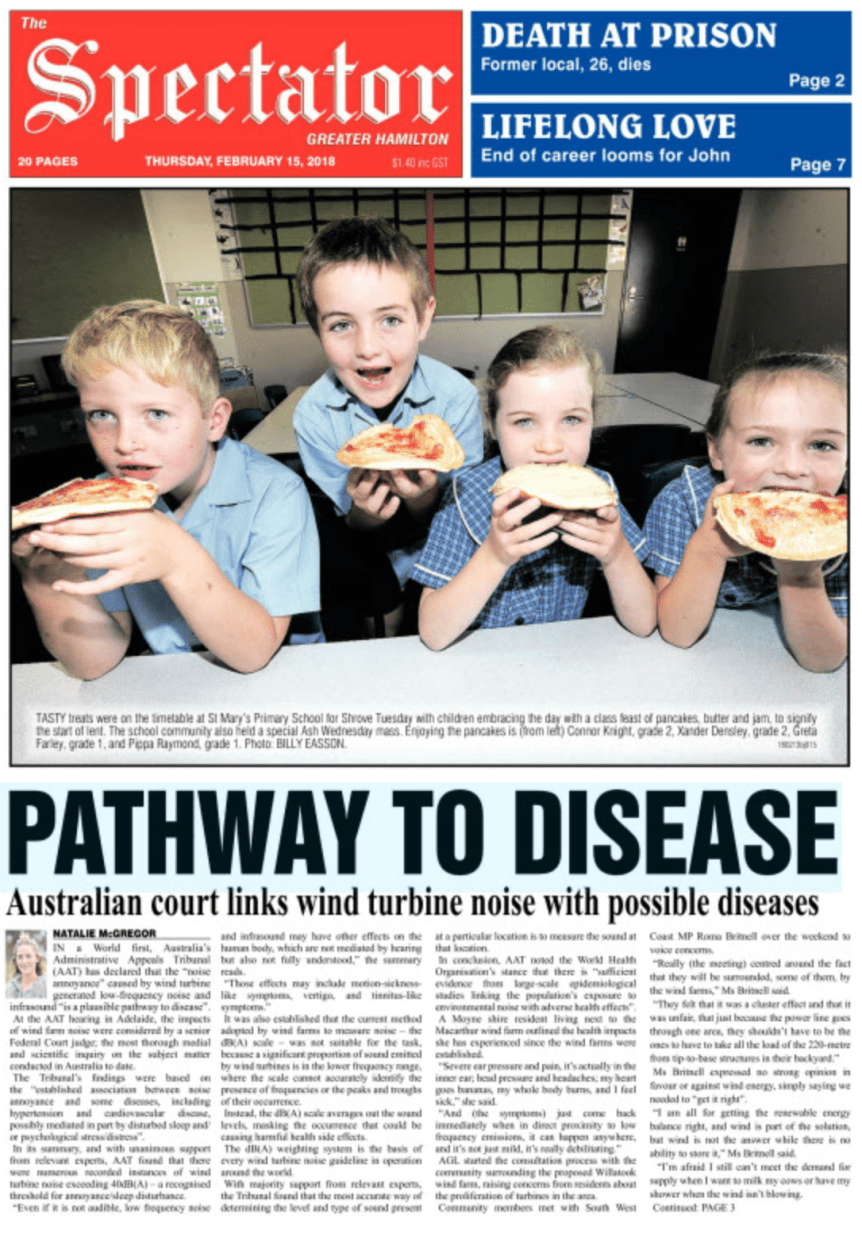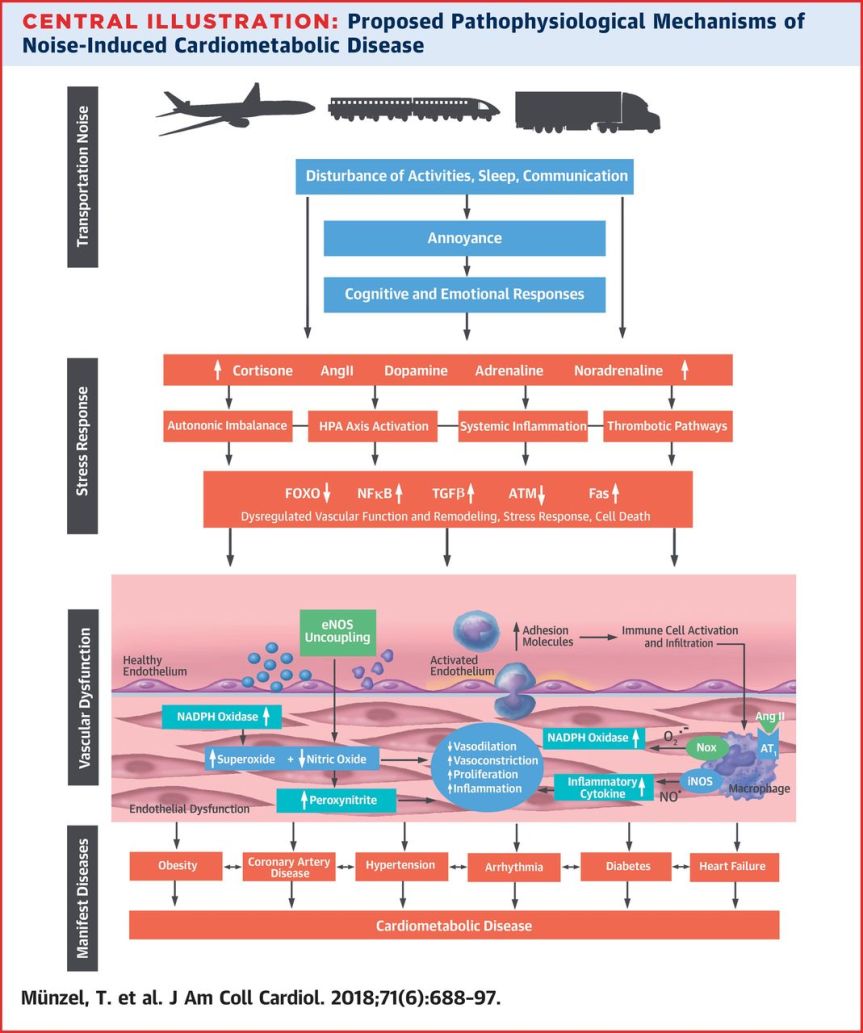Last December, Australia’s Administrative Appeals Tribunal (AAT) held that “noise annoyance” caused by wind turbine generated low-frequency noise and infrasound “is a plausible pathway to disease”, based on the “established association between noise annoyance and some diseases, including hypertension and cardiovascular disease, possibly mediated in part by disturbed sleep and/or psychological stress/distress.”
The AAT also slammed wind turbine noise standards as irrelevant and, therefore, totally unfit for purpose: Australian Court Finds Wind Turbine Noise Exposure a ‘Pathway to Disease’: Waubra Foundation Vindicated
If the case had exonerated wind turbine noise, no doubt, such a story would have been splashed across the front pages of the Fairfax press, and trumpeted long and loud by wind cult central, the ABC.
Instead, The Australian’s Graham Lloyd gave it fleeting coverage but, otherwise, there was complete ‘radio’ silence.
Students of the dark arts well-know that peddling a narrative is as much about what never gets published, as the content of what is.
The wind industry has been alive to the power of manipulating the press, from the get go. Starry-eyed and gullible ‘journalists’ routinely recant wind industry PR, as if gospel fact. Notwithstanding the debacle that’s playing out in wind ‘powered’ South Australia and Victoria (forced load shedding and mass blackouts, whenever the wind stops blowing), in any story purporting to cover these things, journos still add the line that ‘[insert name] wind farm will power 30,000 homes’. Clearly, they’re not kite flyers or sailors, and set themselves up for the obvious retort: when? Every day? Some of the time? Just, when?
Getting the facts about wind power published, warts and all, is in and of itself a triumph. Hence our delight with the following article which appeared in Hamilton’s Spectator.
Natalie McGregor deserves a Walkley Award for having the courage and temerity to publish that which plenty of her peers seem determined never to touch. Hamilton sits in the Western Districts of Victoria, a bucolic, fertile and productive swathe of the country which has already been overrun with turbines and, thanks to Victoria’s lunatic Labor government, is lined up to be speared with hundreds more.
The fact that this piece appeared on the front page of the Spectator signals a shift in favour of communities and against this rotten, subsidy-soaked industry. Nice work, Natalie!
Pathway to Disease: Australian court links wind turbine noise with possible diseases
Hamilton Spectator
Natalie McGregor
15 February 2018
In a World first, Australia’s Administrative Appeals Tribunal (AAT) has declared that the “noise annoyance” caused by wind turbine generated low-frequency noise and infrasound “is a plausible pathway to disease”.
At the AAT hearing in Adelaide, the impacts of wind farm noise were considered by a senior Federal Court judge; the most thorough medial and scientific inquiry on the subject matter conducted in Australia to date.
The Tribunal’s findings were based on the “established association between noise annoyance and some diseases, including hypertension and cardiovascular disease, possibly mediated in part by disturbed sleep and/or psychological stress/distress”.
In its summary, and with unanimous support from relevant experts, AAT found that there were numerous recorded instances of wind turbine noise exceeding 40 dB(A) — a recognised threshold for annoyance/sleep disturbance.
“Even if it is not audible, low-frequency noise and infrasound may have other effects on the human body, which are not mediated by hearing but also not fully understood,” the summary reads.
“Those effects may include motion-sickness-like symptoms, vertigo, and tinnitus -like symptoms.”
It was also established that the current method adopted by windfarms to measure noise — the dB(A) scale was not suitable for the task, because a significant proportion of sound emitted by wind turbines is in the lower frequency range, where the scale cannot accurately identify the presence of frequencies or the peaks and troughs of their occurrence.
Instead, the dB(A) scale averages out the sound levels, masking the occurrence that could be causing harmful health side-effects.
The dB(A) weighting system is the basis of every wind turbine noise guideline in operation throughout the world.
With majority support from relevant experts, the Tribunal found that the most accurate way of determining the level and type of sound present at a particular location is to measure the sound at that location.
In conclusion, AAT noted the World Health Organisation stance that there is “sufficient evidence from large-scale epidemiological studies linking the populations exposure to environmental noise with adverse health effects”.
A Moyne shire resident living next to the MacArthur windfarm outlined the health impacts she has experienced since the wind farms were established.
“Severe ear pressure and pain, it’s actually in the inner ear; head pressure and headaches; my heart goes bananas, my whole body burns, and I feel sick,” she said.
“And (the symptoms) just come back immediately when in direct proximity to low-frequency emissions, it can happen anywhere, and it’s not just mild, it’s really debilitating.”
AGL started the consultation process with the community surrounding the proposed Willatook windfarm, raising concerns from residents about the proliferation of turbines in the area.
Community members met with South West Coast MP Roma Britnell over the weekend to voice concerns.
“Really (the meeting) centred around the fact that they will be surrounded, some of them, by the wind farms,” Ms Britnell said.
“They felt that it was a cluster effect and that it was unfair, that just because the power line goes through one area, they shouldn’t have to be the ones to had to take all the load of the 220-metre from tip- two-base structures in their backyard.”
Ms Britnell expressed no strong opinion in favour or against wind energy, simply saying we need to “get it right”.
“I am all for getting the renewable energy balance right, and wind is part of the solution, but wind is not the answer where there is no ability to store it,” Ms Britnell said.
“I’m afraid I still can’t meet the demand for supply when I want to milk my cows or have my shower when the wind isn’t blowing.
“Wind is not meeting the baseload and the biggest restriction I hear from community members is the supply issue, and that’s what the government is really not addressing.”
Tony Edney, director of the water foundation — an advocacy group for properly conducted, multidisciplinary research into health problems reported by people living in the vicinity of wind turbines and other industrial uses — told the Spectator that not every windfarm would necessarily generate problems.
“The location, topography, layout and design of the installation of factors that combine with climactic conditions to produce sound generating profiles of potential harm for some receiver sites,” Mr Edney said.
“And not everyone is adversely affected by wind farm noise. It is in part a matter of individual sensitivity or propensity, think of seasickness, and how we are not impacted equally by that malaise.”
Mr Edney said it was “simply no longer possible” for the industry to say that its technology was “clean, green and completely harmless”.
“Country people deserve to know what exactly they are dealing with when talk starts up about our windfarm proposed for their district,” Mr Edney said.
Hamilton Spectator
The AAT’s findings were based on a raft of scientific studies directed at dealing with exposure to low-frequency noise, in general; not just that generated by wind turbines.
Pulsing, low-frequency wind turbine noise is just another kind of annoying environmental noise which, as the AAT found, leads to cardiovascular disease. That very topic is covered in the article below, from the Journal of the American College of Cardiology.
For Natalie McGregor’s interest and benefit here’s another very recent example of the kind of work the AAT relied on.
Proposed Pathophysiological Mechanisms of Noise-Induced Cardiometabolic Disease Noise causes annoyance and stress responses characterized by activation of the hypothalamic-pituitary-adrenal axis, inflammation, thrombosis, and altered gene expression. See text, section “Potential (molecular) mechanisms underlying noise-induced cardiovascular disease,” for details. Modified/combined from Münzel et al. (73) with permission of the publisher. Copyright © 2017, Oxford University Press. Ang II = angiotensin II; AT1 = angiotensin receptor type 1; ATM = ataxia telangiectasia mutated; eNOS = endothelial nitric oxide synthase; Fas = cell death signaling molecule (CD95); FOXO = Forkhead box O; HPA = hypothalamic-pituitary-adrenal; iNOS = inducible nitric oxide synthase; NADPH = nicotinamide adenine dinucleotide phosphate; Nox = NADPH oxidase; NO = nitric oxide; O2 = oxygen; TGF = transforming growth factor.
Environmental Noise and the Cardiovascular System
Journal of the American College of Cardiology 71(6) 688-697.
, , , , and
February 2018
Abstract
Noise has been found associated with annoyance, stress, sleep disturbance, and impaired cognitive performance. Furthermore, epidemiological studies have found that environmental noise is associated with an increased incidence of arterial hypertension, myocardial infarction, heart failure, and stroke. Observational and translational studies indicate that especially nighttime noise increases levels of stress hormones and vascular oxidative stress, which may lead to endothelial dysfunction and arterial hypertension. Novel experimental studies found aircraft noise to be associated with oxidative stress–induced vascular damage, mediated by activation of the NADPH oxidase, uncoupling of endothelial nitric oxide synthase, and vascular infiltration with inflammatory cells. Transcriptome analysis of aortic tissues from animals exposed to aircraft noise revealed changes in the expression of genes responsible for the regulation of vascular function, vascular remodeling, and cell death. This review focuses on the mechanisms and the epidemiology of noise-induced cardiovascular diseases and provides novel insight into the mechanisms underlying noise-induced vascular damage.
Summary and Conclusions
The presented evidence further strengthens the concept that transportation noise per se contributes to the development of cardiovascular risk of coronary artery disease, arterial hypertension, stroke, and heart failure.
With regard to understanding the pathophysiological mechanisms, a growing body of evidence finds that noise is associated with oxidative stress, vascular dysfunction, autonomic imbalance, and metabolic abnormalities, potentiating not only the adverse impact of cardiovascular risk factors, such as arterial hypertension and diabetes, but also contributing to the progression of atherosclerosis and increased susceptibility to cardiovascular events.
Thus, there is increasing rationale for studying the interaction between this novel risk factor and its collective impact on cardiometabolic diseases. The questions that need to be addressed are many and include the magnitude and time course of response to coexposure of noise and air pollution; synergistic effects of both exposures on surrogate measures, such as blood pressure and metabolic risk; duration of effect/time course of reversal; impact of low-grade background noise exposure on air pollution exposure effects and vice versa; impact of noise on the circadian rhythm; and finally the effects on lifestyle (e.g., diet, stress, and exercise).
Journal of the American College of Cardiology





See windturbinesyndrome.com or read the book, published by Nina Pierpont, MD, PhD
I had a feeling that Hamilton would play a part in exposing this despicable industry. The medical facilities in the town have been superb in my experience and the staff open to discussion about our health issues living near a wind farm. The local Vet has also been understanding about our concerns for animal welfare around industrial scale wind turbines. The same cannot be said for other regional centres in the surrounding area in my opinion. Although this may change as more evidence comes to light.
If only the AMA and NHMRC would be more willing to come forward on the issue and adopt a precautionary approach. As long as they stand firm on this nocebo nonsense, the easier it is for less considerate Doctors to be let off the hook by simply stating to patients that there is no evidence of wind turbine syndrome coming up on their computer.
To quote Little Britain, “Computer says NO”.
In light of the above AAT findings, are we now to receive a public apology from the AMA and NHMRC?
Nocebo? Nobraino more like.
Natalie McGregor – I am so very proud of you for your strength and integrity and I have no doubt there are millions around the world who join my feelings about that. Victims of wind turbines have known for years the truth of what the AAT has said and congratulations to the AAT as well but how gutless and how dishonest and how soul destroying that journalists refuse to even report that decision. Now that Christian religion has been pushed out of public consciousness ( at least for the time being) the word ‘evil’ takes on new meaning in place of the role of the biblical devil and to my mind it is now appropriate to use it in the modern context to mean ‘keeping the public in the dark and denying them the reality of the truth’ and that is what the wind industry does and that is what journalists do by not reporting the truth but reporting propaganda to support their preferred agenda – great work Natalie and thank you.
Reblogged this on UPPER SONACHAN WIND FARM.